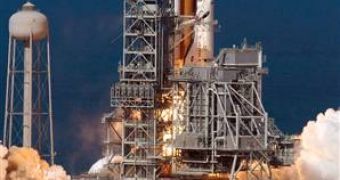On May 31, 2008 the Discovery space shuttle was launched into space from the Launch Pad 39A at NASA's Kennedy Space Center in the STS-124 mission destined to deliver the second section of the massive Japanese space laboratory Kibo to the International Space Station. All went well during liftoff and afterwards, although the launch pad was far from OK. A total of 5,300 bricks had been dislodged from the flame trench of the launch pad and thrown off several meters away as the space shuttle started up its engines, exposing the concrete wall beneath.
Launch Pad 39A was built during the 1960s to serve the Apollo missions and now it looks like the bricks of the flame trench did not adhere to the thick concrete wall as they should have during construction. LeRoy Cain, chairman of the mission management team, said that the bricks themselves did not pose any danger to the space shuttle and repairs to the flame trench would start immediately so that the launch pad could be available for the next launch scheduled in October.
Meanwhile, the crew of the space shuttle Discovery have departed the ISS after completing the main objectives of STS-124 and relaxed for a day before proceeding with the re-entry into Earth's atmosphere scheduled for tomorrow. The nose and wing inspection of the heat shield of the orbiter, usually conducted before docking to the space station, had to be delayed until Thursday after the departure, since the inspection boom of the shuttle needed to be retrieved from the ISS.
The sheer massive scale of Kibo left little room to spare in the cargo bay of the space shuttle, which had been anticipated by NASA by sending the inspection boom of Discovery to the ISS during the STS-123 mission.
The damaged area of the flame trench measures approximately 6 by 22 meters and sits exactly bellow the rocket booster engines of the space shuttle, helping deflect the resulted gases during ignition and liftoff. "We need to go understand more. I don't know if it surprises me. I don't think we know enough yet for me to say that", Caid added.
The problem with rebuilding the damaged area is that the specific types of fire resistant bricks originally used are no longer fabricated by the respective company, not to mention that although NASA is capable of repairing the damage with or without those particular types of bricks, it has not yet decided whether or not it is reasonable to do so. After all, the space shuttles are set to retire in less than two years.
Launch Pad 39A will need to be used to launch the Atlantis space shuttle on October 8 in its maintenance and upgrade mission to the Hubble Space Telescope. The space shuttle Endeavor will be ready to rescue the crew of Atlantis in case the shuttle is damaged in any way and cannot return to Earth on its own.

 14 DAY TRIAL //
14 DAY TRIAL //